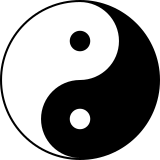Back • Return Home
An Interpretation of Taoism (Part 1)
• 无极 (Wújí) literally means "without ridgepole". The "ridgepole" is the beam in the center of a roof that connects the two slanted halves of it. Therefore, it is like saying "non-dual" or "without polarity". It is Undifferentiated Wholeness, the Absolute Potential out of which everything arises. We could represent it by a circle.
• The first thing to arise out of Wújí are 阴 (Yīn) and 阳 (Yáng), literally "darkness" and "lightness". The literal translation of these two terms may not fully convey the extent to which they can be applied, for Yīn and Yáng are actually every polarity that could possibly exist.
In other words, Yīn and Yáng interchange with one another to form everything, or to use the more traditional term, 一万件事 (YīwànJiànShì) meaning "The Ten-Thousand Things". (The number "ten-thousand" in this context is, of course, not literal. It merely refers to a vast quantity and has a similar connotation to the Greek word "myriad", which also is a mathematical unit of 10,000.) Yīn and Yáng are like a Cosmic Mother and Father, and all manifest things are like their children. This process is described by the 易经 (Yìjīng) or "The Scripture on Changes".
• On its surface, the Yìjīng is a system of "divination" (i.e.: a way of assessing the influences predominant in one's life so as to make the most constructive choices). Within the Yìjīng, Yīn and Yáng are represented by a "broken line" and an "unbroken line", respectively:

Permutations of these Yīn and Yáng lines are symbolic of different kinds of influences and are often given very poetic interpretations. The term "Scripture on Changes" leads one to believe that these collections of lines are actually configurations of space and time. The Yìjīng is able to provide helpful feedback to any question that one may ask through it because it is an embodiment of the archetypes inherent to space and time. All of space and time arise from Yīn and Yáng, which in turn, arise from Wújí!
• While the Yìjīng can be a useful tool, one must cultivate a continual moment-by-moment of awareness of Wújí. It must be integrated into one's being as a way of living. This is called the 道 (Dào), literally "path" or "way".
One technique for doing this is called 无为 (Wúwéi), often translated as "inaction". If we were to interpret the term more literally, we could translate it as to be "not for [something]". In other words, it is describing a state of dynamic balance wherein we are neither "for" things nor "against" things, but merely accepting of the Truth inherent to each thing as it arises. If we accept all things as containing some nugget of Truth, then we do not vacillate from one extreme to another.
This is why it is often said that the Dào "cannot be named". It is not some specific set of rules to follow or ideas to learn. In the case of human beings, whatever any one person accepts as "true" makes sense to them within the context of their own experience at any given moment. If we thoroughly understand and accept such a premise, then it becomes ever easier to get along with one another without necessarily sacrificing our own experience. We spontaneously enact the 三宝 (Sānbǎo) or "three treasures", the virtues of Compassion, Frugality, and Humility. Virtue is always the foundation for all subsequent endeavors, and how "effortless" things seem to become when they are made into a habit.
• If we continue to follow this path, then we eventually come into harmony with 太极 (Tàijí) or the "great pole", which is represented by the following symbol:

This is representative of Yīn and Yáng in their most archetypal form. The black and white portions of the symbol are Yīn and Yáng, respectively. Neither of these is more or less than the other. They both have a useful role to fulfill. Therefore, they are not opposites, but complements. They do not destroy one another, but build each other up in ways that are mutually beneficial. Further, notice how each is actually contained inside of the other. There is a seeming two that is united as One.
In short, they are perfect complements in perfect balance, each being reflected in one another and operating together as One. This reality of seeming dichotomy is actually one of deep symbiosis and synergy. Wújí is not only the One source, the origin of Yīn and Yáng, but also a result of their balanced union. Making every Yīn and Yáng polarity complementary and bringing them into balance with one another leads one back to Wújí. But Wújí is always there, ever-present.
We may summarize all of the above by saying, "It is as easy as 1, 2, 3.": We began with Unity in Wújí, from which a seeming Duality arose in Yīn and Yáng, and finally, to the Harmony of all three in Tàijí.
Wújí + Yīn and Yáng = Tàijí
1 + 2 = 3

